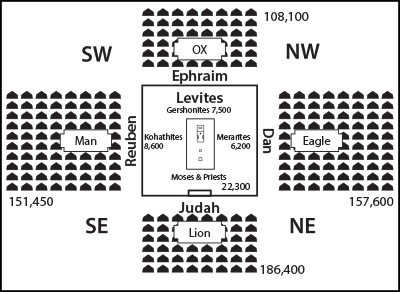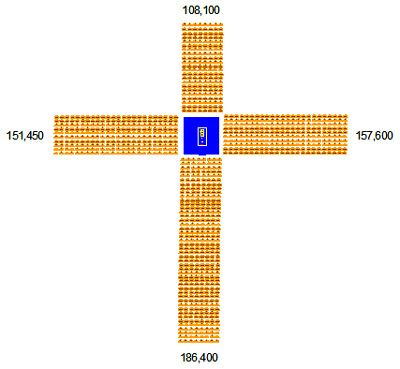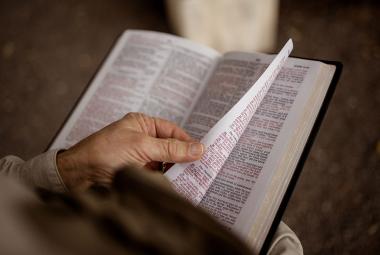In Hebrew, בַּמִּדְבָּר Bmidbar means ''in the wilderness,'' which is the real name of this book. The Greek translators called Ἀριθμοί Arithmoi, and in Latin it was Numeri, because the translators focused on the two census takings at the beginning and the end of the wanderings. But its basically ''the wilderness wanderings.''
Numbers picks up where Exodus left off. And its really a book about arrested progress. In a sense, it never should have happened. It took only 40 hours to get Israel out of Egypt - the Passover. But it took 40 years to get Egypt out of Israel. At Kadesh-Barnea, Moses sent out twelve spies to check out the new land. Ten of them came back terrified, and for good reason. They said they saw the Nephilim, the giant ''fallen ones.'' These were the hybrids that were the products of mischievous angels commingling with women.
Numbers 13:33 records, ''and we were in our own sight as grasshoppers, and so we were in their sight.'' Goliath was also one of those. He was nine feet tall. They had reason to be scared. And yet, it was also a lack of faith. Two of the twelve spies, Joshua and Caleb, had a different attitude and brought the ''minority report.'' They said, ''This land is rich, its full, its marvelous. Let us go up at once and possess it for we are well able to overcome it.'' By their own strength? Of course not. By faith! God said, ''Go take it.'' When Gods on our side, our enemy is outnumbered.
Unfortunately, the people rallied around the ten spies with their bad report. ''And all the children of Israel murmured against Moses and against Aaron: and the whole congregation said to them, Would God that we had died in the land of Egypt, or, Would God that we had died in this wilderness'' (Numbers 14:2). That was a big mistake. God was listening and heard their murmuring and gave them their desires.
God threatened to wipe them out, but Moses interceded, ''If you wipe them out, what will the Egyptians think? They survived all the plagues, and now you're going to wipe them out?'' His arguments are fascinating.
God knows what He is going to do, and says to the nation, ''Your carcasses shall fall in this wilderness and all that were numbered of you, according to your whole number, from 20 years old and upward, which have murmured against me'' (Numbers 14:29). In other words, ''You guys said you wished you'd die; you're going to die. Your kids are going to grow up and go in. Moses was gone for 40 days; you're going to be in the wilderness for 40 years, until this unfaithful generation dies off!''
Only two in the entire group, Joshua and Caleb, survived to go into the Promised Land. Joshua was the military leader who took over after Moses. Caleb was his sidekick. Together, these two rout the most powerful group of nations on the earth at that time.
Why does the Bible record all the things that happened during those 40 years? The Scripture tells us it was for an example. These things happened to them for our admonition. Paul makes a point in 1 Corinthians 10:11 that everything written then is for our application now. Every one of the events in Numbers has a lesson for us. And that's why it is so important to study this book in detail.
The word ''example'' in Greek is τύπος, tupos, which is ''a figure, an image, a pattern, a pre-figuring.'' That's where we get the term ''type,'' or model. Engineers speak of a prototype, which is from the same root. Types are common in the Bible, where some event, some object, or some situation is a lesson, in advance, of what's coming. Manna is a type; the brazen serpent is a type; water from the rock is a type. Were going to examine these three.
Manna
God provided a daily provision of manna. There were several million people wandering in the desert. Have you ever thought about how to feed them? It was a logistical nightmare! But God provided manna, a miracle bread from Heaven. It was provided only on six days, with a double portion on the sixth to prevent it from having to be gathered on the Sabbath Day.
The Brazen Serpent
Moses had to put up with the Israelites gripes and complaints throughout those 40 years. And its funny to hear him talk to God: ''I didn't ask for this job; you gave it to me!'' In response to their murmuring, God sent fiery serpents that killed anyone they bit. Moses prayed and God agreed to provide a remedy, but notice the remedy He chose: Moses was instructed to place a brass serpent on a cross-shaped pole and put it up on a high hill. Everyone who looked at the cross would be spared.
Why this remedy? Jesus explained it in John 3, ''As Moses lifted the serpent in the wilderness, even so must the Son of Man be lifted up on a cross.'' And everyone who looks to it will be spared. This is a prelude to the most famous verse in the Bible: John 3:16.
Its a strange symbol, the brass serpent. Brass means ''judged.'' Serpent means ''sin.'' Jesus is exemplified or symbolized by a brass serpent? Yes. Scripture says He was made sin for us. Sin was judged on that cross.
The Waters at Mirabah
At Rephidim, the Israelites needed water. God told Moses to take the staff and strike the rock and the rock would bring forth water (Exodus 17). Many years later, at Mirabah, again they needed water. This time God told Moses to speak to the rock and it would give water. But Moses was frustrated and upset with his people, and instead of speaking, he struck the rock.
Water came, but Moses had misrepresented God because he let the people think that God was angry with them. Moses penalty for disobedience was that he could not enter the Promised Land.
Moses spent 40 years in Egypt in preparation for this leadership position, then 40 years on the backside of the desert being prepared spiritually. He experienced the incredible drama of the Passover and the Red Sea crossing. Then he shepherded this complaining, grouchy, grumpy bunch through 40 years of hardship in the wilderness. Then God told him that he would see the land from the top of the mountain when they entered, but he would not be able to go in. What had he done that was so bad?
Paul tells us in 1 Corinthians 10:4 that the rock was Christ (speaking idiomatically). There were two episodes with the rock: in the first one, the rock was smitten and they benefited with living water; the second rock was not supposed to be smitten. If Moses had done what God told him, the rocks would have modeled the first and second comings of Jesus Christ. But because he blew it, he blew the model.
But God wasn't finished with Moses yet. He was denied entry into the Promised Land, but well see him again on the Mount of Transfiguration with Jesus talking about the Second Coming. I believe he is also one of the witnesses who shows up in Revelation 11.
The Camp of Israel
There is one other interesting type that's found in Numbers 2. The 12 tribes were told to group into four camps. Each tribe had a standard and symbol, but Judah, Isaachar and Zebulin were to rally around the standard of Judah. They collectively represented 186,400. Reuben, Simeon and Gad collectively represented about 151,000. Ephraim, Manasseh and Benjamin collectively represented 108,100. Dan, Asher and Naphtali, 157,600. Judah's standard was the Lion of the Tribe of Judah. Reubens was a man. Ephraim's was the ox. Dan, the eagle. These four symbols are also the four faces of the cherubim around the throne of God in Isaiah 6 , Ezekiel 1 and 10, and Revelation 4.
 Each of the camps, of three tribes each, was to encamp on one of the four cardinal compass directions (N, S, E, or W) with respect to the camp of the Levites enclosing the tabernacle. We can only guess at how much space was required by the Levites, whether it was 100 feet on a side, 100 yards, or whatever. But whatever it was, well assume that length as a basic unit.
Each of the camps, of three tribes each, was to encamp on one of the four cardinal compass directions (N, S, E, or W) with respect to the camp of the Levites enclosing the tabernacle. We can only guess at how much space was required by the Levites, whether it was 100 feet on a side, 100 yards, or whatever. But whatever it was, well assume that length as a basic unit.
To fully appreciate all of the implications, you must try to think like a rabbi; you need to maintain an extremely high respect for the precise details of the instructions. They resorted to heroic measures in their attempt to comply with the letter of the law.
The Camp of Judah had to camp east of the Levites. This poses a technical problem. Notice that if the breadth of their camp was larger than that of the Levites, the excess would be southeast or northeast, not east. Therefore, if they were to comply strictly to their instructions, their camp could only be as wide as that of the Levites, and they then would have to extend eastward to obtain whatever space they required.
The camps of Reuben, Ephraim, and Dan had the same constraint on the south, west, and north, respectively. The length of each leg would thus be proportional to the total population in each camp. If we assemble what we can infer from the Biblical account, we can imagine what the camp of Israel looked like from above: the tabernacle and the Levites in the center, surrounded by the four faces of the tribal standards, and each of the four camps of Judah, Ephraim, Reuben, and Dan, stretching out in the four cardinal directions. We can also tally the size of each tribe to total the relative length of each camp as they stretched out in each of the four directions.

The Book of Numbers is a fascinating study in many ways. Expositionally, it demonstrates integrity of Design; homiletically, it reveals that these were real people with practical problems; and, devotionally, we see that ''crossing over Jordon'' is not ''going to Heaven'' - life is a warfare. Each one of us is in our own ''wilderness'' and every day is our ''Kadesh-Barnea'' - will we trust God and ''conquer the land''? Will we resolutely try to surmount the obstacles that lie in our way or will we shrink from the apparent difficulties and remain slaves to the sin in our lives?







